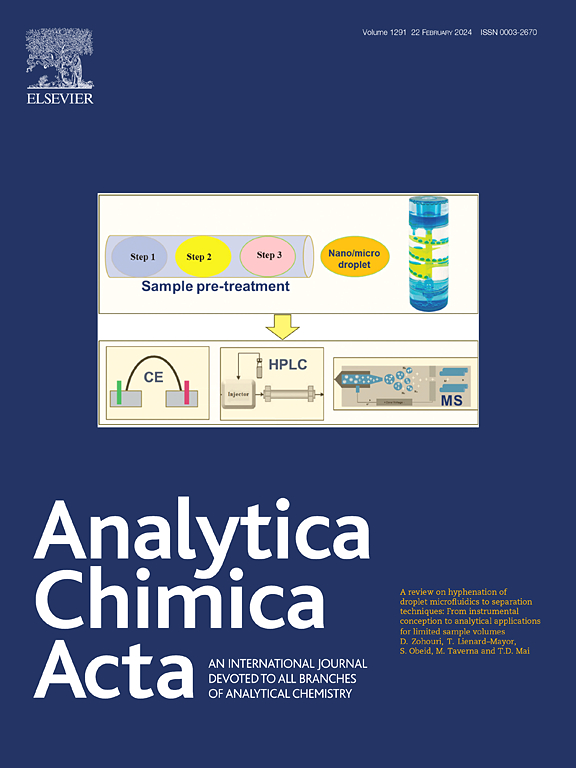基于电迁移的不连续电解质系统中生物样品脱盐和缓冲液替换的3D打印设备
IF 5.7
2区 化学
Q1 CHEMISTRY, ANALYTICAL
引用次数: 0
摘要
DNA样本的质量和产量对下游分析至关重要。复杂的生物或环境样品含有干扰化合物,需要先进的方案来去除盐,小有机分子和/或蛋白质,而不影响原始样品中的DNA片段分布。在试图去除高浓度无机样品成分时,通常采用标准提取方法来区分高分子量DNA片段。结果在此,我们介绍了一种简单的装置,用于在不连续电解质系统中进行复杂生物样品的简化、纯化、脱盐和缓冲交换。该装置结合了一个3d打印的身体和两个电解质储液器,以及带有透析膜作为插入物的市售盒式磁带。当通过电解液储存器内的电极施加电流时,样品离子被注入盒或其中一个电解液储存器,电迁移穿过透析膜。在这个过程中,小的样品离子穿过膜,并被加载到电解质储存器中的选定缓冲液的离子所取代。较大的离子,如DNA片段或蛋白质,留在样品储存库中。使用血浆中的DNA样本评估该装置的性能。几毫升血浆样品在30分钟内纯化,DNA回收率为90%。该设备能够快速有效地纯化高度复杂的样品。它可以很容易地缩放可用的样品量(从微升到毫升)和分析物的大小通过选择适当的膜孔径。优化了该装置在高含盐量DNA样品上的适用性,并对血浆样品进行了测试。但它也具有纯化/脱盐多种生物化合物的潜力,包括蛋白质、多肽或带电寡糖,以及细胞器、细胞、病毒或细菌。本文章由计算机程序翻译,如有差异,请以英文原文为准。

Biological sample desalting and buffer replacement based on electromigration in a discontinuous electrolyte system using a 3D printed device
Background
The quality and yield of DNA specimens are essential for downstream analyses. Complex biological or environmental samples contain interfering compounds requiring advanced protocols for removing salts, small organic molecules, and/or proteins without compromising the DNA fragments distribution in the original sample. High-molecular-weight DNA fragments are often discriminated by standard extraction methods in attempts to remove the highly concentrated inorganic sample components.
Results
Here, we introduce a simple device for the simplification, purification, desalting, and buffer exchange of complex biological samples based on electrodialysis in discontinuous electrolyte systems. The device combines a 3D-printed body with two electrolyte reservoirs and commercially available cassettes with dialysis membranes as inserts. Upon applying an electric current via electrodes inside the electrolyte reservoirs, the sample ions, injected into the cassette or one of the electrolyte reservoirs, electromigrate across the dialysis membranes. During this process, small sample ions pass through the membrane and are substituted by the ions of the selected buffers loaded into the electrolyte reservoirs. The larger ions, such as DNA fragments or proteins, stay in the sample reservoir. The performance of the device was evaluated using DNA samples in blood plasma. Several milliliters of a plasma sample were purified in 30 min with 90 % DNA recovery.
Significance
The device enables fast and effective purification of highly complicated samples. It can be easily scaled for the available sample amount (ranging from microliters to milliliters) and the analyte size of interest by selecting appropriate membrane pore sizes. The device's applicability was optimized on DNA samples with high salt content and tested on plasma samples. But it also has the potential for purification/desalting of a wide range of biological compounds, including proteins, peptides, or charged oligosaccharides, as well as organelles, cells, viruses, or bacteria.
求助全文
通过发布文献求助,成功后即可免费获取论文全文。
去求助
来源期刊

Analytica Chimica Acta
化学-分析化学
CiteScore
10.40
自引率
6.50%
发文量
1081
审稿时长
38 days
期刊介绍:
Analytica Chimica Acta has an open access mirror journal Analytica Chimica Acta: X, sharing the same aims and scope, editorial team, submission system and rigorous peer review.
Analytica Chimica Acta provides a forum for the rapid publication of original research, and critical, comprehensive reviews dealing with all aspects of fundamental and applied modern analytical chemistry. The journal welcomes the submission of research papers which report studies concerning the development of new and significant analytical methodologies. In determining the suitability of submitted articles for publication, particular scrutiny will be placed on the degree of novelty and impact of the research and the extent to which it adds to the existing body of knowledge in analytical chemistry.
 求助内容:
求助内容: 应助结果提醒方式:
应助结果提醒方式:


